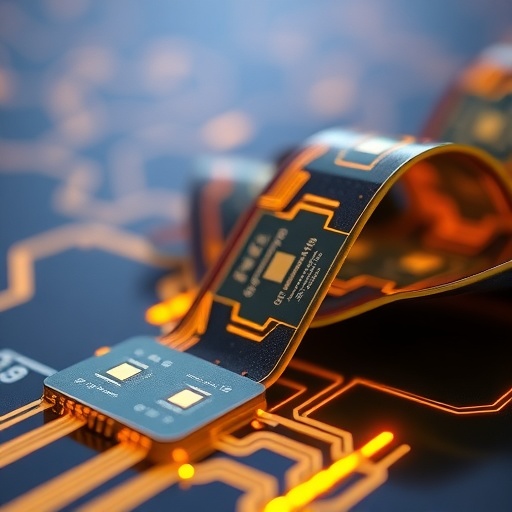Flexible electronics mark an incredible leap forward in technology, allowing for devices that can bend, stretch, and adapt to the contours of human body and environment. With applications ranging from wearable health monitors to advanced robotics, the quest for materials that can meet the demanding criteria of flexibility, stretchability, and durability has intensified. At the forefront of this exploration is a material that might seem unexpected in such high-tech applications: natural rubber. Emerging research published in the renowned journal Small highlights the potential of this organic material as a sustainable option for reducing the carbon footprint associated with electronic innovations.
Natural rubber has long been valued for its mechanical properties, which include excellent elasticity, strength, and resilience. However, the shift towards an eco-conscious approach in technology development prompts researchers to investigate how these properties can be harnessed, modified, and integrated into modern flexible electronics. A detailed review presents the transformative possibilities of natural rubber in a variety of applications. These applications include innovative sensors that can monitor physiological changes, self-powered systems capable of energy harvesting, and self-healing materials that maintain functionality despite wear and tear.
The review meticulously describes how natural rubber can be adapted to enhance its electrical and mechanical properties. For instance, blending natural rubber with conductive materials could lead to the development of sensors and devices capable of transmitting data efficiently without compromising their flexibility. Strategies like chemical modifications and composite formations have shown promise in increasing the conductivity while retaining the beneficial traits of rubber. This approach aligns perfectly with trends in materials science, where the goal is to endow traditional substances with modern capabilities through innovative technology.
.adsslot_sqh4Fi6Wwb{width:728px !important;height:90px !important;}
@media(max-width:1199px){ .adsslot_sqh4Fi6Wwb{width:468px !important;height:60px !important;}
}
@media(max-width:767px){ .adsslot_sqh4Fi6Wwb{width:320px !important;height:50px !important;}
}
ADVERTISEMENT
Despite its potential, the use of natural rubber in electronics is not without challenges. One significant hurdle is the variability inherent in natural rubber production, which can lead to inconsistencies in material performance. This variability requires a deep understanding of both the cultivation and processing of natural rubber to ensure that the properties of the final product meet the rigorous standards expected in the electronics industry. Moreover, researchers are exploring the life cycle of natural rubber, aiming to strike a balance between sustainable sourcing and high-tech application, which could revolutionize how we think about materials in electronics.
Professor Titash Mondal, a key figure in this field of study from the Indian Institute of Kharagpur, emphasizes the implications of their findings. He notes that his team’s ongoing work illustrates how natural rubber and its derivatives can pave the way for a new generation of environmentally friendly electronic devices. By melding advances in material science with sustainable practices, this research exemplifies a broader trend towards creating technologies that do not just serve consumers but also promote sustainability.
The exploration of natural rubber as a key material in flexible electronics also opens avenues for practical applications that could reshape various industries. For example, in healthcare, sensors made from natural rubber could be integrated into wearables that track real-time biological data, enhancing patient monitoring without the bulk associated with current technologies. In the realm of robotics, soft actuators constructed using natural rubber could yield robots that interact safely with humans in healthcare settings, manufacturing, and even entertainment.
Moreover, as the demand for energy-efficient devices rises, self-powered systems using natural rubber-based triboelectric nanogenerators present an innovative solution. These systems could harness environmental energy from motion or vibrations to power small electronic devices. The integration of sustainable materials into energy-generating systems not only reflects a commitment to reducing carbon emissions but also offers a practical, effective solution to meet global energy needs.
Ongoing research is anticipated to further unravel the complexities associated with the reevaluation of natural rubber within the context of modern technology. The authors of the review call on the scientific community to broaden the dialogue around the use of natural materials in electronics, urging a collective effort to push the boundaries of conventional understanding and application. This shift from petroleum-based polymers to renewable options like natural rubber could lead to a revolution in how electronic devices are manufactured and perceived.
Looking forward, the collaboration between academia and industry will be vital. Identifying the right partners who share a vision for sustainable innovation can accelerate the transition from laboratory discoveries to real-world applications. By establishing a robust pathway for commercialization, the potential of natural rubber to transform flexible electronics extends far beyond research laboratories, reaching practical implementation and consumer markets.
In conclusion, the research documenting the advantages of incorporating natural rubber into flexible electronics is a testament to human ingenuity and adaptability. As we seek solutions to global challenges, the merging of sustainability and advanced technology through materials like natural rubber exemplifies our potential to innovate responsibly. The examination of natural rubber within this context heralds a new era where the electronics of tomorrow could become synonymous with sustainability and efficiency, fostering a future where technology and the planet coexist harmoniously.
Subject of Research: The potential of natural rubber in flexible electronics.
Article Title: From Trees to Tech: The Contribution of Natural Rubber in Next-Gen Flexible Electronics.
News Publication Date: 6-Aug-2025.
Web References: Small Journal, Wiley.
References: Available upon request from the publisher.
Image Credits: © Wiley.
Keywords
Sustainability, Natural Rubber, Flexible Electronics, Energy Harvesting, Wearable Devices, Triboelectric Nanogenerators, Eco-friendly Materials, Technology Innovation, Self-powered Systems, Soft Robotics, Mechanical Properties, Electronic Sensors.
Tags: applications of flexible electronicscarbon footprint reduction in technologyeco-friendly electronic innovationsenergy harvesting systemsmechanical properties of rubbernatural rubber in flexible electronicsproperties of natural rubberresearch on sustainable electronicsself-healing materials in electronicssustainable materials for technologytransforming traditional materials for modern applicationswearable health monitors technology





